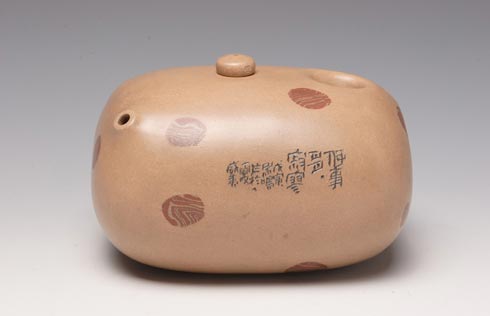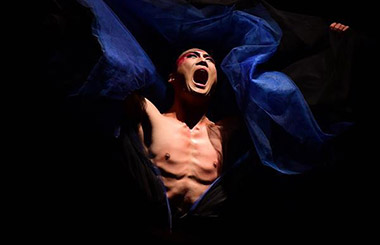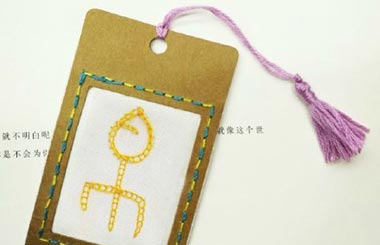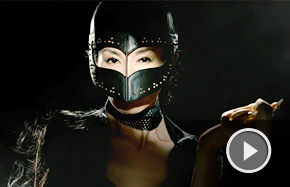Rare Ming royal stem bowl to feature at Christie's auction
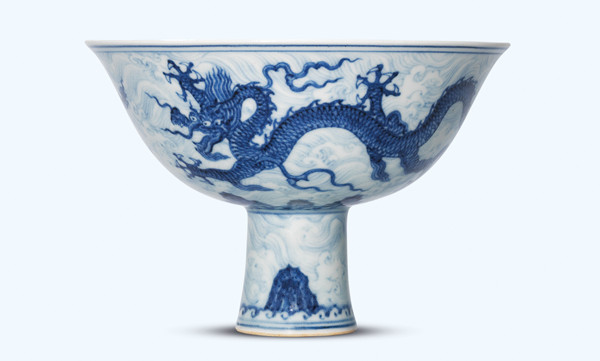 |
|
The 15th-century stem bowl is up for sale. [Photo provided to China Daily] |
A 15th-century qinghua (blue-and-white) stem bowl that was meant for the sacrificial rituals of Chinese emperors will go under the hammer at Christie's sale in Hong Kong on Nov 30.
The bowl from the Ming Dynasty (1368-1644) features two five-clawed dragons-symbol of imperial power. One dragon charges ahead and the other looks back, above cresting waves and mountains.
The bowl's inside features a six-character mark in the center circled by double rings-which indicates that it was "produced in the reign of Xuande (1426-35)", the title of Emperor Zhu Zhanji during whose reign the production of blue-and-white ware reached its peak.
Further, the mark is surrounded by shadow patterns of striding dragons that are hard to spot at first sight.
Typically, the blue-and-white ceramics were coated with cobalt-blue pigment from Persia and made at high temperatures. And the final result still amazes connoisseurs of Chinese porcelain, both at home and abroad.
The stem bowl celebrates the technical and aesthetic achievements of the Xuande reign, not only with its refined technique of penciling the dragons, the waves and other decorative patterns, according to Ruben Lien from the Christie's department of Chinese ceramics and works of art, but also because it exhibits well-balanced and varying tones of blue. The dragons and the peaks are painted in a rich blue, while the rolling waves are in a soft, pale blue.
He says the contrast in the coloring marks a "breakthrough" for the period, exemplifying the artisans' control over the cobalt pigments.
The bowl is owned by a collector from the United States. It fetched HK$35 million ($4.51 million) at a Sotheby's auction in Hong Kong in 2007.
Including this bowl, no more than six examples of bowls of a similar design and size are in existence, Lien says.
Some of them are in the collections of Paris-based Musee Guimet and the Palace museums in Beijing and Taipei. Of the bowls in private hands, one from the noted Meiyintang Collection was sold for HK$112.7 million in Hong Kong in 2012.
Lien says Ming Dynasty porcelain, especially that produced in the early stages of the empire, such as the Xuande and the Yongle periods, have recently attracted increased attention from collectors who previously eyed only Qing Dynasty (1644-1911) royal objects.
Speaking about the bowl, he says: "As Xuande and Yongle ceramics available in the market are not as numerous as Qing objects from the reigns of Kangxi, Yongzheng and Qianlong (the porcelain-making peaks of the Qing Dynasty), a fine, rare specimen (like the bowl) is bound to draw people's attention."
"Rising interest has also brought in new buyers," he says.
A blue-and-white jar also from the Xuande period and bearing a five-clawed dragon grossed HK$158 million at a Christie's sale in Hong Kong in May. It was owned by a Swiss family and was used to store walking sticks.
In April, Sotheby's staged in Hong Kong an auction of British collector Roger Pilkington's ceramics and works of art from the Song (960-1279), Ming and early Qing dynasties. Ming cobalt-blue ware comprised the top five lots at the sale that yielded nearly HK$503 million in total.
Besides the Xuande stem bowl, Christie's will also auction two ceramic pieces made in the official kilns of Qing emperor Yongzheng. Both feature common subjects such as flowers and birds.
One is a falangcai (enameled) cup on which plum blossoms and trees and bamboos are painted in yellow, green and brown against a ruby-red ground. The depiction of a pair of hovering bees over the flowering plum branch makes it a rarity among such ware, says Lien.
The subjects signify longevity, wealth and happiness, and the vivid, souffle-like texture of the ruby ground enhances its elegance.
The cup belonged to the late Hu Huichun, a porcelain connoisseur whose Zandelou collection is hailed one of the best private collections of Chinese art from the 20th century.
Hu moved to Hong Kong from Shanghai in the 1950s and co-founded the prominent collectors' group Min Chui Society. He donated a large part of his collection to the Shanghai Museum.
Lien says after Hu's death, his family sold the Yongzheng cup to the current owner, meaning that the item has come to auction for the first time, or as "fresh goods" as described in the trade.
The other piece is a moon-shaped blue-and-white flask. One side has two magpies resting on a blossoming plum branch, and the other has two bulbuls on an apricot tree. The exquisitely balanced composition can be traced to Northern Song paintings. The motif was a favorite of Emperor Yongzheng during whose reign similar designs were produced.






